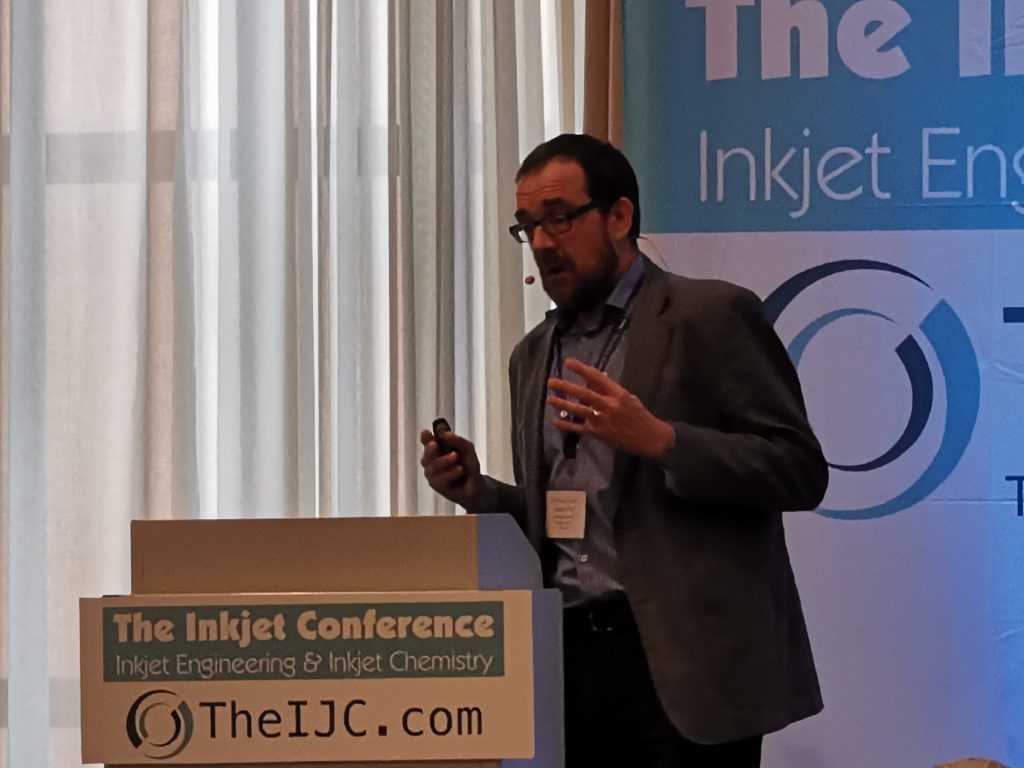Since this story is a direct follow-on to last week’s story about new printheads, it seems sensible to start with Konica Minolta’s new KM1280iMHH-S, as discussed by Paddy O’Hara, director of business development for Industrial Inkjet Ltd (IIJ).
Most of Konica Minolta’s printheads produce either large drops at 360dpi resolution for coding and marking applications, or small drops at 600 to 1200 dpi for high quality graphics. So the KM1280iMHH is designed to fit in the middle of the portfolio, producing 450dpi with a medium drop size from 1280 nozzles. The first release will be a version for single pass variable data applications, where it can produce large enough drops for higher speeds, but with enough resolution for fine text. It can also be used to print white and spot varnish as well as for direct to shape printing, and materials deposition uses.
This series of heads will feature a silicon nozzle plate for better drop accuracy at higher speeds. It has a print width of 72mm, with 450npi, able to produce a native 10pl drop volume with a typical firing frequency of 40KHz. It can handle solvent, oil, and UV inks, with a viscosity of 7-12mPa•s and theres also an option for an internal heater. It also has the same footprint of the KM1024i series and uses similar drive electronics so that it should be possible to integrate fairly easily. It’s due to be available next year.
O’Hara says that IIJ has been working with Konica Minolta for around a dozen years, both supplying these printheads to the European market and using them to develop a range of inkjet print modules. He described how Konica Minolta found after taking over the Panasonic printhead business that Panasonic had been tuning wave forms for every head, for each colour for every customer, adding: ”That’s insanity. Konica Minolta produce robust waveforms that work for a range of applications. Being able to work with a wide range of fluids makes integration easier.”
He says: “The heads have built-in heaters and can handle a range of viscosity.” He points out that Konica Minolta developed a gel UV ink for the AccurioJet KM1 and that this will now be available to other OEM customers, noting: “It’s more complex than a standard ink system so there will be a little bit more support.”
 Paddy O’Hara, director of business development for Industrial Inkjet.
Paddy O’Hara, director of business development for Industrial Inkjet.
O’Hara questioned what sort of features people should look for in a print head, saying that not every application needed high resolution. He added: There’s a demand from the market for cheaper. But this stuff is cripplingly expensive to develop and to make perfect so a constant question of cost per nozzle will squeeze people out of the market.”
He says that one of the guiding principles at IIJ is to keep everything as simple as possible, adding: “The more complex a system the higher the R&D costs and you will be later to market. And the more complex the system you build the more potential for things to go wrong.” Thus IIJ keep the heads together and avoid pining between colours to create very compact print modules.
O’Hara then went on to make a good argument for using compact printheads, pointing out that the Konica Minolta heads do tend to have a fairly small footprint. This matters in scanning applications, such as wide format printing, because it makes for a smaller print shuttle. This in turn helps to cut the cost of the printer, as its easier to move a smaller shuttle, and it also leads to better bi-directional print accuracy.
Using compact printheads also helps with direct to shape printers as it allows for a smaller distance between the rows and therefore the ability to print to smaller radiuses. And, of course, the smaller the overall printer, the cheaper it is to build it.
There’s an even more compelling reason for using compact heads on a single pass web-fed printer as it reduces the risk of movement of the web between the colours. Naturally, the more compact the print unit, the easier it is to retrofit it to an existing machine. IIJ has used the Konica Minolta printheads to develop a highly effective range of print modules, including four-colour units that are not much bigger than some monochrome units. O’Hara says this is partly because keeping the heads close together means there’s no need for an arch design, and no pinning between the colours, which also saves on cost….
To read the article in full please follow this link: https://www.nessancleary.co.uk/the-ijc-pt2-from-printhead-modules-to-the-new-km1280imhh-s/